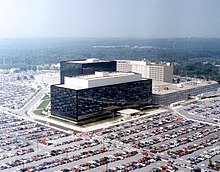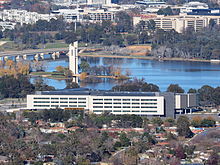
Back Five Eyes Afrikaans خمس أعين Arabic Пет очи Bulgarian ফাইভ আইস Bengali/Bangla Five Eyes Catalan Five Eyes Czech Cinco Ojos Spanish Viis Silma Estonian فایو آیز Persian Five Eyes French
Five Eyes | |
|---|---|
 Members shown in blue | |
| Working language | English |
| Type | Intelligence alliance |
| Members | |
| Establishment | |
| August 14, 1941 | |
| May 17, 1943 | |





The Five Eyes (FVEY) is an Anglosphere intelligence alliance comprising Australia, Canada, New Zealand, the United Kingdom, and the United States.[1] These countries are party to the multilateral UK-USA Agreement, a treaty for joint cooperation in signals intelligence.[2][3][4] Informally, "Five Eyes" can refer to the group of intelligence agencies of these countries. The term "Five Eyes" originated as shorthand for a "AUS/CAN/NZ/UK/US EYES ONLY" (AUSCANNZUKUS) releasability caveat.[5]
The origins of the FVEY can be traced to informal, secret meetings during World War II between British and American code-breakers which took place before the US formally entered the war.[6] The alliance was formalized in the post-war era by the UKUSA Agreement in 1946. As the Cold War deepened, the intelligence sharing arrangement was formalised under the ECHELON surveillance system in the 1960s.[7] This system was developed by the FVEY to monitor the communications of the Soviet Union and Eastern Bloc; it is now used to monitor communications worldwide.[8][9] The FVEY expanded its surveillance capabilities during the course of the "war on terror", with much emphasis placed on monitoring the Internet. The alliance has grown into a robust global surveillance mechanism, adapting to new domains such as international terrorism, cyberattacks, and contemporary regional conflicts.
The alliance's activities, often shrouded in secrecy, have occasionally come under scrutiny for their implications on privacy and civil liberties, sparking debates and legal challenges. In the late 1990s, the existence of ECHELON was disclosed to the public, triggering a debate in the European Parliament and, to a lesser extent, the United States Congress and British Parliament. Former NSA contractor Edward Snowden described the Five Eyes as a "supra-national intelligence organisation that does not answer to the known laws of its own countries".[10] 2010s global surveillance disclosures revealed FVEY was spying on one another's citizens and sharing the collected information with each other, although the FVEY nations maintain this was done legally.[11][12]
Five Eyes is among the most comprehensive espionage alliances.[13] Since processed intelligence is gathered from multiple sources, the information shared is not restricted to signals intelligence (SIGINT) and often involves military intelligence (MILINT), human intelligence (HUMINT), and geospatial intelligence (GEOINT). Five Eyes remains a key element in the intelligence and security landscape of each member country, providing them a strategic advantage in understanding and responding to global events.
- ^ "Five Eyes Intelligence Oversight and Review Council (FIORC)". www.dni.gov. Archived from the original on 21 January 2021. Retrieved 5 June 2020.
- ^ Cox, James (December 2012). "Canada and the Five Eyes Intelligence Community" (PDF). Canadian Defence and Foreign Affairs Institute. Archived from the original (PDF) on 10 September 2015. Retrieved 24 July 2016.
- ^ "Five Eyes". United States Army Combined Arms Center. Archived from the original on 2 February 2014. Retrieved 18 January 2014.
- ^ "PKI Interoperability with FVEY Partner Nations on the NIPRNet". United States Department of the Navy. Archived from the original on 1 February 2014. Retrieved 18 January 2014.
- ^ Cox, James (December 2012). "Canada and the Five Eyes Intelligence Community" (PDF). Canadian Defence and Foreign Affairs Institute. Archived from the original (PDF) on 4 December 2013.
- ^ Vucetic, Srdjan (April 2020). "CANZUK: Fantasy or potential reality?: CANZUK anyone?". Diplomat & International Canada (Spring 2020). Archived from the original on 21 April 2024. Retrieved 21 April 2024.
- ^ "Five Eyes and the Perils of an Asymmetric Alliance – AIIA". Australian Institute of International Affairs. Archived from the original on 10 April 2021. Retrieved 8 March 2021.
- ^ Asser, Martin (6 July 2000). "Echelon: Big brother without a cause?". BBC News. Archived from the original on 25 January 2014. Retrieved 28 January 2014.
- ^ "Q&A: What you need to know about Echelon". BBC News. 29 May 2001. Archived from the original on 18 December 2013. Retrieved 28 January 2014.
- ^ Cite error: The named reference
ndrwas invoked but never defined (see the help page). - ^ Ball, James (20 November 2013). "US and UK struck secret deal to allow NSA to 'unmask' Britons' personal data". The Guardian. Archived from the original on 20 January 2014. Retrieved 18 January 2014.
- ^ Cite error: The named reference
reuters1was invoked but never defined (see the help page). - ^ Perry, Nick; Dodds, Paisley (17 July 2013). "5-nation spy alliance too vital for leaks to harm". AP News. Associated Press. Archived from the original on 21 April 2024. Retrieved 21 April 2024.